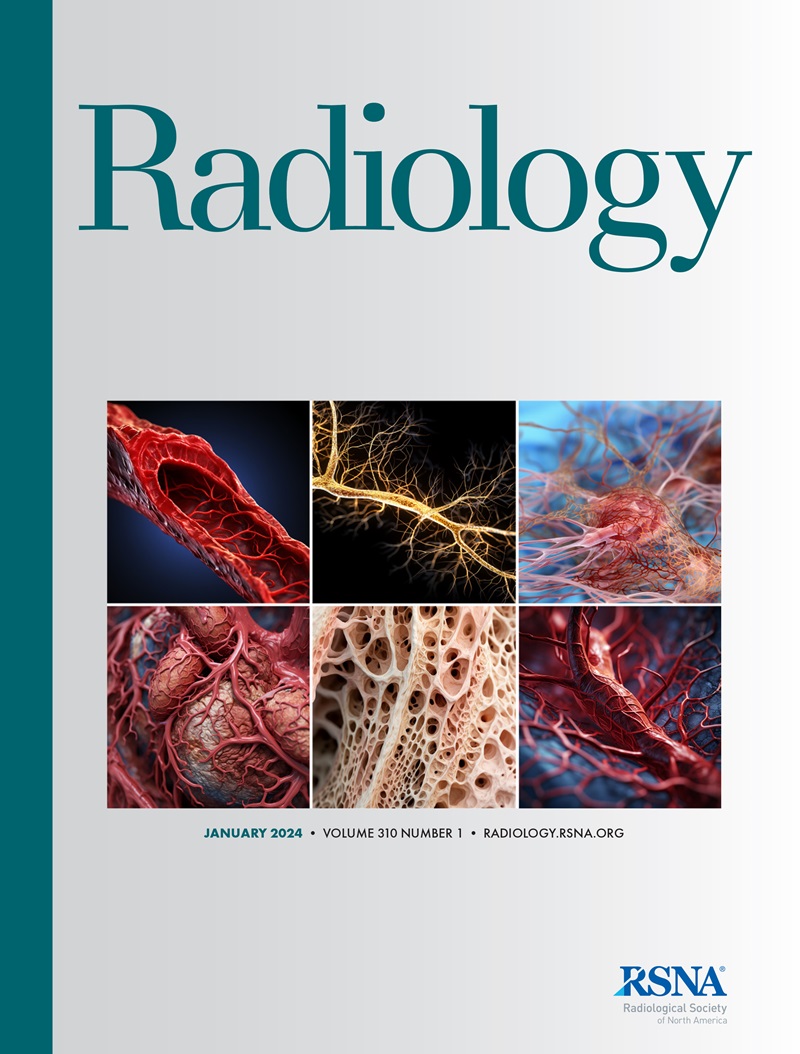Multireader Diagnostic Accuracy of Abbreviated Breast MRI for Screening Women with Extremely Dense Breasts.
IF 12.1
1区 医学
Q1 RADIOLOGY, NUCLEAR MEDICINE & MEDICAL IMAGING
Sophie E L van Grinsven, Ritse M Mann, Evelyn M Monninkhof, Katya Duvivier, Mathijn D F de Jong, Petra K de Koekkoek-Doll, Claudette E Loo, Ruud M Pijnappel, Rogier van der Sluijs, Jeroen Veltman, Carla H van Gils, Wouter B Veldhuis
求助PDF
{"title":"Multireader Diagnostic Accuracy of Abbreviated Breast MRI for Screening Women with Extremely Dense Breasts.","authors":"Sophie E L van Grinsven, Ritse M Mann, Evelyn M Monninkhof, Katya Duvivier, Mathijn D F de Jong, Petra K de Koekkoek-Doll, Claudette E Loo, Ruud M Pijnappel, Rogier van der Sluijs, Jeroen Veltman, Carla H van Gils, Wouter B Veldhuis","doi":"10.1148/radiol.241233","DOIUrl":null,"url":null,"abstract":"<p><p>Background Abbreviated MRI may reduce costs and time of supplemental breast cancer screening. The Dense Tissue and Early Breast Neoplasm Screening (DENSE) trial provides an opportunity to study this protocol in a true screening population. Purpose To compare multireader diagnostic accuracy of various abbreviated screening breast MRI protocols with that of the full multiparametric protocol in the DENSE trial, focusing on identifying the minimal protocol necessary to maintain high diagnostic accuracy. Materials and Methods In this secondary analysis of a subset from the DENSE trial, seven radiologists performed incremental readings of first-round screening MRI scans in women with extremely dense breasts and findings negative for cancer at mammography. Different sequences were added in four incremental steps. The first step included both high-temporal low-spatial and low-temporal high-spatial dynamic T1-weighted series, up to 120 seconds after contrast agent injection. The final step added all full-protocol sequences. Each radiologist assessed the same MRI scans and provided Breast Imaging Reporting and Data System scores for all four incremental steps. Pooled sensitivity and specificity were calculated across all readers per step using a generalized estimating equation model, and pooled reading time per step was calculated using a linear mixed model. Results The first-round screening included 518 MRI scans from 518 women (median age, 53 years; IQR, 51-59 years), including 83 breast cancers: 68 invasive cancers (82%) and 15 ductal carcinomas in situ (18%). There was no evidence of a difference in sensitivity between abbreviated protocol (84.3%; 95% CI: 77.7, 89.2) and the full multiparametric MRI protocol (85.9%; 95% CI: 80.0, 90.3; <i>P</i> = .68). There was also no evidence of a difference in specificity between abbreviated protocol (73.9%; 95% CI: 70.7, 76.9) and full protocol (75.8%; 95% CI: 72.8, 78.5; <i>P</i> = .39). The abbreviated protocol had a pooled reading time (49.7 seconds; 95% CI: 48.5, 50.9) that was almost 50% shorter than the full protocol (96.4 seconds; 95% CI: 94.3, 98.5; <i>P</i> < .001) with 70%-80% shorter scanning time, depending on hospital and scanner vendor. Conclusion In women in the DENSE trial with extremely dense breasts and findings that were negative for cancer at mammography, abbreviated breast MRI for first-round screening had high diagnostic accuracy that was comparable to full multiparametric protocol, at much shorter reading and scanning times. ClinicalTrials.gov Identifier: NCT01315015 © RSNA, 2025 <i>Supplemental material is available for this article.</i> See also the editorial by Kataoka and Honda in this issue.</p>","PeriodicalId":20896,"journal":{"name":"Radiology","volume":"315 2","pages":"e241233"},"PeriodicalIF":12.1000,"publicationDate":"2025-05-01","publicationTypes":"Journal Article","fieldsOfStudy":null,"isOpenAccess":false,"openAccessPdf":"","citationCount":"0","resultStr":null,"platform":"Semanticscholar","paperid":null,"PeriodicalName":"Radiology","FirstCategoryId":"3","ListUrlMain":"https://doi.org/10.1148/radiol.241233","RegionNum":1,"RegionCategory":"医学","ArticlePicture":[],"TitleCN":null,"AbstractTextCN":null,"PMCID":null,"EPubDate":"","PubModel":"","JCR":"Q1","JCRName":"RADIOLOGY, NUCLEAR MEDICINE & MEDICAL IMAGING","Score":null,"Total":0}
引用次数: 0
引用
批量引用
Abstract
Background Abbreviated MRI may reduce costs and time of supplemental breast cancer screening. The Dense Tissue and Early Breast Neoplasm Screening (DENSE) trial provides an opportunity to study this protocol in a true screening population. Purpose To compare multireader diagnostic accuracy of various abbreviated screening breast MRI protocols with that of the full multiparametric protocol in the DENSE trial, focusing on identifying the minimal protocol necessary to maintain high diagnostic accuracy. Materials and Methods In this secondary analysis of a subset from the DENSE trial, seven radiologists performed incremental readings of first-round screening MRI scans in women with extremely dense breasts and findings negative for cancer at mammography. Different sequences were added in four incremental steps. The first step included both high-temporal low-spatial and low-temporal high-spatial dynamic T1-weighted series, up to 120 seconds after contrast agent injection. The final step added all full-protocol sequences. Each radiologist assessed the same MRI scans and provided Breast Imaging Reporting and Data System scores for all four incremental steps. Pooled sensitivity and specificity were calculated across all readers per step using a generalized estimating equation model, and pooled reading time per step was calculated using a linear mixed model. Results The first-round screening included 518 MRI scans from 518 women (median age, 53 years; IQR, 51-59 years), including 83 breast cancers: 68 invasive cancers (82%) and 15 ductal carcinomas in situ (18%). There was no evidence of a difference in sensitivity between abbreviated protocol (84.3%; 95% CI: 77.7, 89.2) and the full multiparametric MRI protocol (85.9%; 95% CI: 80.0, 90.3; P = .68). There was also no evidence of a difference in specificity between abbreviated protocol (73.9%; 95% CI: 70.7, 76.9) and full protocol (75.8%; 95% CI: 72.8, 78.5; P = .39). The abbreviated protocol had a pooled reading time (49.7 seconds; 95% CI: 48.5, 50.9) that was almost 50% shorter than the full protocol (96.4 seconds; 95% CI: 94.3, 98.5; P < .001) with 70%-80% shorter scanning time, depending on hospital and scanner vendor. Conclusion In women in the DENSE trial with extremely dense breasts and findings that were negative for cancer at mammography, abbreviated breast MRI for first-round screening had high diagnostic accuracy that was comparable to full multiparametric protocol, at much shorter reading and scanning times. ClinicalTrials.gov Identifier: NCT01315015 © RSNA, 2025 Supplemental material is available for this article. See also the editorial by Kataoka and Honda in this issue.
短缩乳腺MRI对乳腺极致密女性的多读诊断准确性。
背景:短时间MRI可以减少辅助乳腺癌筛查的费用和时间。致密组织和早期乳腺肿瘤筛查(Dense)试验为在真正的筛查人群中研究这一方案提供了机会。目的:在DENSE试验中,比较各种简短筛查乳腺MRI方案与完整多参数方案的多阅读器诊断准确性,重点确定维持高诊断准确性所需的最小方案。材料和方法在对DENSE试验子集的二次分析中,7名放射科医生对乳房密度极高且乳房x光检查结果为癌症阴性的女性进行了第一轮MRI筛查扫描的增量读数。不同的序列按4个递增步骤添加。第一步包括高时间低空间和低时间高空间动态t1加权序列,直至注射造影剂后120秒。最后一步添加所有完整协议序列。每个放射科医生评估相同的MRI扫描,并为所有四个增量步骤提供乳腺成像报告和数据系统评分。使用广义估计方程模型计算所有读者每步的合并敏感性和特异性,使用线性混合模型计算每步的合并阅读时间。第一轮筛查包括518名女性的518次MRI扫描(中位年龄53岁;IQR, 51-59岁),包括83例乳腺癌:68例浸润性癌(82%)和15例导管原位癌(18%)。没有证据表明简化方案(84.3%;95% CI: 77.7, 89.2)和完整的多参数MRI方案(85.9%;95% ci: 80.0, 90.3;P = .68)。也没有证据表明两种简化方案在特异性上存在差异(73.9%;95% CI: 70.7, 76.9)和完整方案(75.8%;95% ci: 72.8, 78.5;P = .39)。简化的协议有一个集合读取时间(49.7秒;95% CI: 48.5, 50.9),比完整方案(96.4秒;95% ci: 94.3, 98.5;P < 0.001),扫描时间缩短70%-80%,具体取决于医院和扫描仪供应商。在DENSE试验中,乳房密度极高且乳房x光检查结果为阴性的女性中,第一轮筛查的简短乳房MRI具有与完整的多参数方案相当的高诊断准确性,且读取和扫描时间更短。ClinicalTrials.gov标识符:NCT01315015©RSNA, 2025本文提供补充材料。参看片冈和本田在本期的社论。
本文章由计算机程序翻译,如有差异,请以英文原文为准。

 求助内容:
求助内容: 应助结果提醒方式:
应助结果提醒方式:


